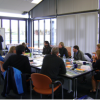|
|
Agile Metrics: Velocity Is Not the Goal Velocity is one of the most common metrics used-and one of the most commonly misused-on agile projects. Velocity is simply a measurement of speed in a given direction-the rate at which a team is delivering toward a product release. As with a vehicle en route to a particular destination, increasing the speed may appear to ensure a timely arrival. However, that assumption is dangerous because it ignores the risks with higher speeds. And while it’s easy to increase a vehicle’s speed, where exactly is the accelerator on a software team? Michael “Doc" Norton walks us through the Hawthorne Effect and Goodhart’s Law to explain why setting goals for velocity can actually hurt a project's chances. Take a look at what can negatively impact velocity, ways to stabilize fluctuating velocity, and methods to improve velocity without the risks.
|
Michael Norton, LeanDog
|
|
|
Designing Agility Practices that Last Every day more agile practices and styles emerge, overlap, and compete. This proliferation challenges you to choose from among XP, Scrum, lean, Kanban, or the ways of the emerging Lean Start Up crowd. Rather than stumbling down one path or another, join David Hussman as he shares tools for assessing and designing an agile process with practices that address your specific needs and constraints. David starts by teaching a simple assessment process to help you understand where you are today. Then, he offers ideas for selecting a meaningful set of practices and moves on to teach you how to create a meaningful and measurable coaching plan. David covers the selection of product planning tools, iterative delivery tools, tracking tools, and more. If you want to clear the fog about which agile practice will really help you, come for some answers. Even if you don’t yet know what questions to ask, David can help.
|
David Hussman, DevJam
|
|
|
Adding Good User Experience Practices into Agile Development Whose job is it to ensure that the user has a good experience with a new application? As agile processes are taught today, the user experience (UX) design practice is usually left out or at best described as an optional team role. However, the companies that build useful, usable, and desirable software know that UX is baked into the whole development process. Jeff Patton describes what user experience design is and isn’t, and how every person on the team has something to contribute. Hear concrete examples of how companies have adapted their UX practice to work well in an agile context and, along the way, discovered innovative UX practices that work better in agile contexts. Jeff explores pragmatic personas, guerrilla user research, design sketching, lightweight prototyping, and concept testing. Leave with valuable tips for adding UX practices and thinking to your agile process to help you get good user experience.
|
Jeff Patton, Jeff Patton & Associates
|
|
|
Transition to Agile: Large Technical Debt, Small Project When you transition to agile and you have a reasonably size codebase, chances are quite good that you’ve been working on the product for a while. You certainly have legacy ways of thinking about the code and the tests. Now learn how to work yourself out of the technical debt you have accumulated.
|
|
 |
Making Agile Work for Government: Perceived Challenges to Agile Adoption Erich Knausenberger and Raj Shah examine three perceived challenges to agile adoption in the government space and explore how the "blended approach" to agile adoption offers an effective response to each.
|
|
 |
Making Agile Work for Government: A Blended Approach As technology development programs represent some of the biggest line items on agency budgets, there should be little surprise that agile development, with its promise of a fast, lightweight, and iterative approach to delivery of value, has caught the attention of officials from across the government space as they seek to improve their programs’ productivity and effectiveness.
|
|
 |
Livestock Improvement Goes Agile Livestock Improvement Corporation (LIC) is one of the largest integrated herd-improvement organizations in the world. This is the story of how LIC transitioned from a successful, traditional development process to one with hyper-productive agile teams that produce software faster, better, and cheaper.
|
|
|
|
Focus on Value First: An Agile Transformation Competency Framework Organizational transformation is difficult work. Many agile transformation efforts begin with lofty goals only to be sabotaged by unrealistic expectations about the depth and complexity of the changes required. Often, resistance to change is ingrained in an organization’s value system and difficult to overcome. Tamara Runyon presents an overview of a new Agile Transformation Competency Framework-a strategic tool for evaluating and guiding your transformation efforts. Evaluating the organization against the dimensions of the framework-collaboration, agile engineering, product management, environment, organizational culture, and distributed teams-results in a transformation plan that avoids setting unachievable expectations. To institutionalize agile values within an organization and lay the foundation for wide-scale adoption, a company must align with these six competency areas.
|
Tamara Runyon, CollabNet
|
|
|
Agile Pathologies: People Problems in Agile Shops For agile adoptions that fail, you may not be sure of what went wrong or exactly where but you know something is broken somewhere. And with success, you often do not know what went right. Rajeev Singh shares his experiences regarding emotional and behavioral problems on teams trying to embrace agile values and practices. Join with your peers and hear Rajeev's tales of timid managers, ineffective product owners, poor agile coaches, and self-organizing teams that attempt to "run the asylum." He offers case studies of times when agile adoption has put organizations’ strengths and will to the test. Rajeev will help you develop an acute awareness of your organization's pathologies and offer specific paths to resolve these issues. If your agile team or teams are having "people problems" and sometimes seem to be in chaos, this session is for you.
|
Rajeev Singh, ThoughtWorks Inc
|
 |
TOSCA OneView
Video
End to end testing for 21st century business applications (multiple technologies). Rapid test automation for agile software development teams. Test case design as the way to cost effective regression test sets.
|
Anastasios Kyriakopoulos, Tricentis
|
